Nutrition Diploma Assignment 13: Dietary Management of Diseases
VerifiedAdded on 2020/05/03
|26
|5658
|46
Homework Assignment
AI Summary
This homework assignment from a Nutrition Diploma program provides an overview of several health conditions and their dietary management. It covers arthritis, asthma, the common cold, cardiovascular disease, the use of diuretics, and type 1 diabetes. The assignment outlines the causes, symptoms, and dietary recommendations for each condition. For arthritis, it highlights foods to avoid. For asthma, it distinguishes between childhood and adult-onset asthma and suggests preventive measures. It discusses the treatment of a common cold, including rehydration and herbal remedies. Cardiovascular disease is explained concerning diet and lifestyle, and diuretics are discussed regarding their function and potential misuse. Finally, the assignment addresses type 1 diabetes, including its symptoms and dietary focus. This assignment offers a comprehensive understanding of the role of nutrition in managing these health issues.
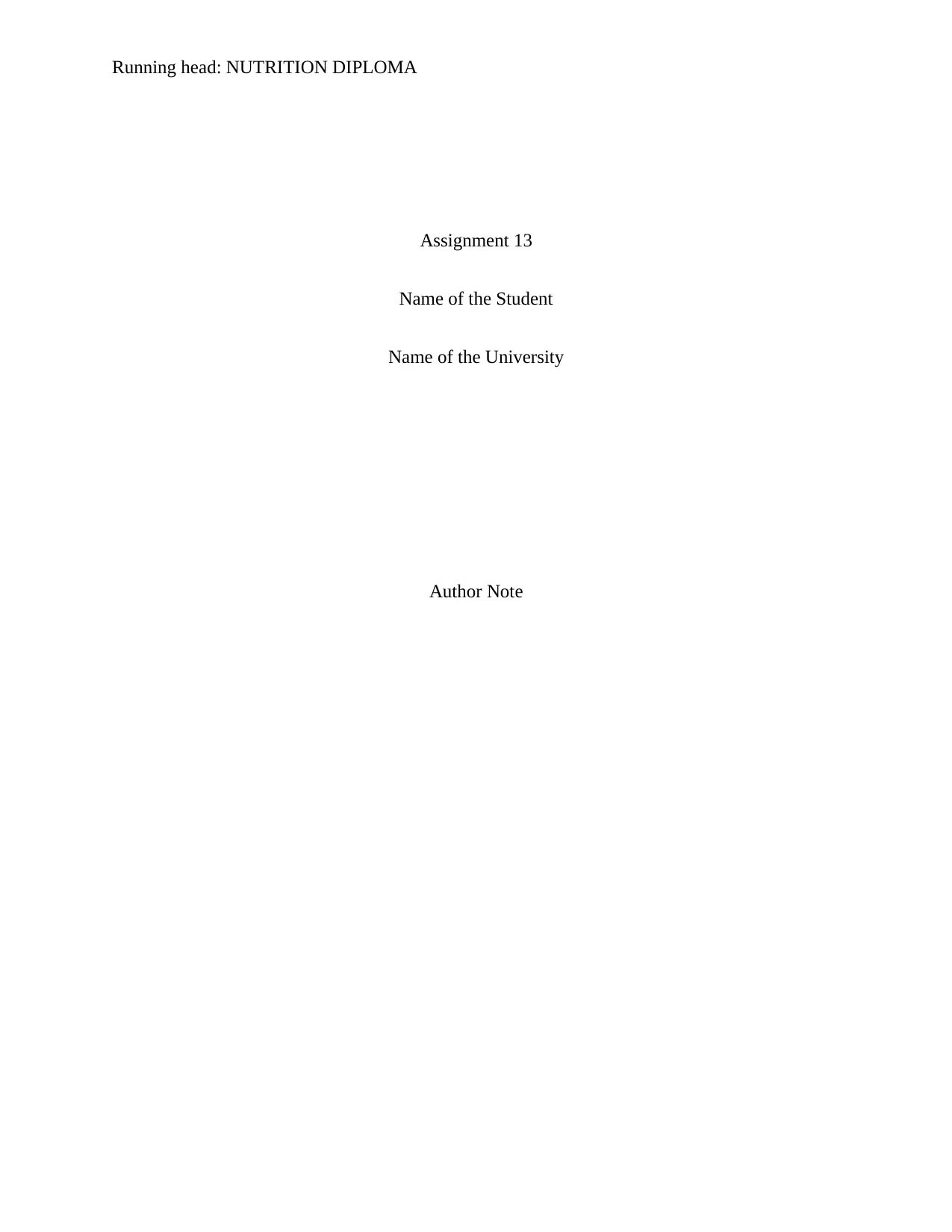
Running head: NUTRITION DIPLOMA
Assignment 13
Name of the Student
Name of the University
Author Note
Assignment 13
Name of the Student
Name of the University
Author Note
Paraphrase This Document
Need a fresh take? Get an instant paraphrase of this document with our AI Paraphraser
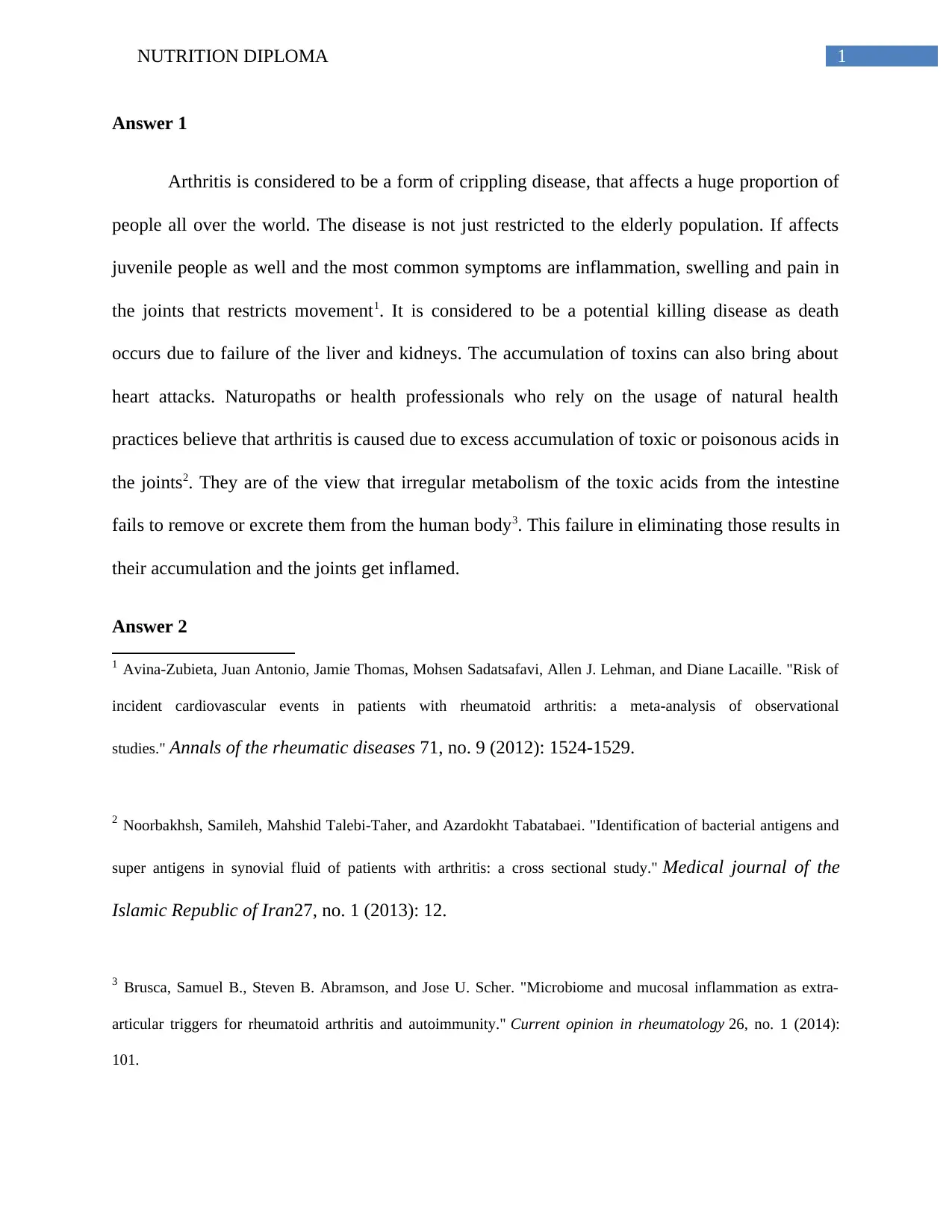
1NUTRITION DIPLOMA
Answer 1
Arthritis is considered to be a form of crippling disease, that affects a huge proportion of
people all over the world. The disease is not just restricted to the elderly population. If affects
juvenile people as well and the most common symptoms are inflammation, swelling and pain in
the joints that restricts movement1. It is considered to be a potential killing disease as death
occurs due to failure of the liver and kidneys. The accumulation of toxins can also bring about
heart attacks. Naturopaths or health professionals who rely on the usage of natural health
practices believe that arthritis is caused due to excess accumulation of toxic or poisonous acids in
the joints2. They are of the view that irregular metabolism of the toxic acids from the intestine
fails to remove or excrete them from the human body3. This failure in eliminating those results in
their accumulation and the joints get inflamed.
Answer 2
1 Avina-Zubieta, Juan Antonio, Jamie Thomas, Mohsen Sadatsafavi, Allen J. Lehman, and Diane Lacaille. "Risk of
incident cardiovascular events in patients with rheumatoid arthritis: a meta-analysis of observational
studies." Annals of the rheumatic diseases 71, no. 9 (2012): 1524-1529.
2 Noorbakhsh, Samileh, Mahshid Talebi-Taher, and Azardokht Tabatabaei. "Identification of bacterial antigens and
super antigens in synovial fluid of patients with arthritis: a cross sectional study." Medical journal of the
Islamic Republic of Iran27, no. 1 (2013): 12.
3 Brusca, Samuel B., Steven B. Abramson, and Jose U. Scher. "Microbiome and mucosal inflammation as extra-
articular triggers for rheumatoid arthritis and autoimmunity." Current opinion in rheumatology 26, no. 1 (2014):
101.
Answer 1
Arthritis is considered to be a form of crippling disease, that affects a huge proportion of
people all over the world. The disease is not just restricted to the elderly population. If affects
juvenile people as well and the most common symptoms are inflammation, swelling and pain in
the joints that restricts movement1. It is considered to be a potential killing disease as death
occurs due to failure of the liver and kidneys. The accumulation of toxins can also bring about
heart attacks. Naturopaths or health professionals who rely on the usage of natural health
practices believe that arthritis is caused due to excess accumulation of toxic or poisonous acids in
the joints2. They are of the view that irregular metabolism of the toxic acids from the intestine
fails to remove or excrete them from the human body3. This failure in eliminating those results in
their accumulation and the joints get inflamed.
Answer 2
1 Avina-Zubieta, Juan Antonio, Jamie Thomas, Mohsen Sadatsafavi, Allen J. Lehman, and Diane Lacaille. "Risk of
incident cardiovascular events in patients with rheumatoid arthritis: a meta-analysis of observational
studies." Annals of the rheumatic diseases 71, no. 9 (2012): 1524-1529.
2 Noorbakhsh, Samileh, Mahshid Talebi-Taher, and Azardokht Tabatabaei. "Identification of bacterial antigens and
super antigens in synovial fluid of patients with arthritis: a cross sectional study." Medical journal of the
Islamic Republic of Iran27, no. 1 (2013): 12.
3 Brusca, Samuel B., Steven B. Abramson, and Jose U. Scher. "Microbiome and mucosal inflammation as extra-
articular triggers for rheumatoid arthritis and autoimmunity." Current opinion in rheumatology 26, no. 1 (2014):
101.
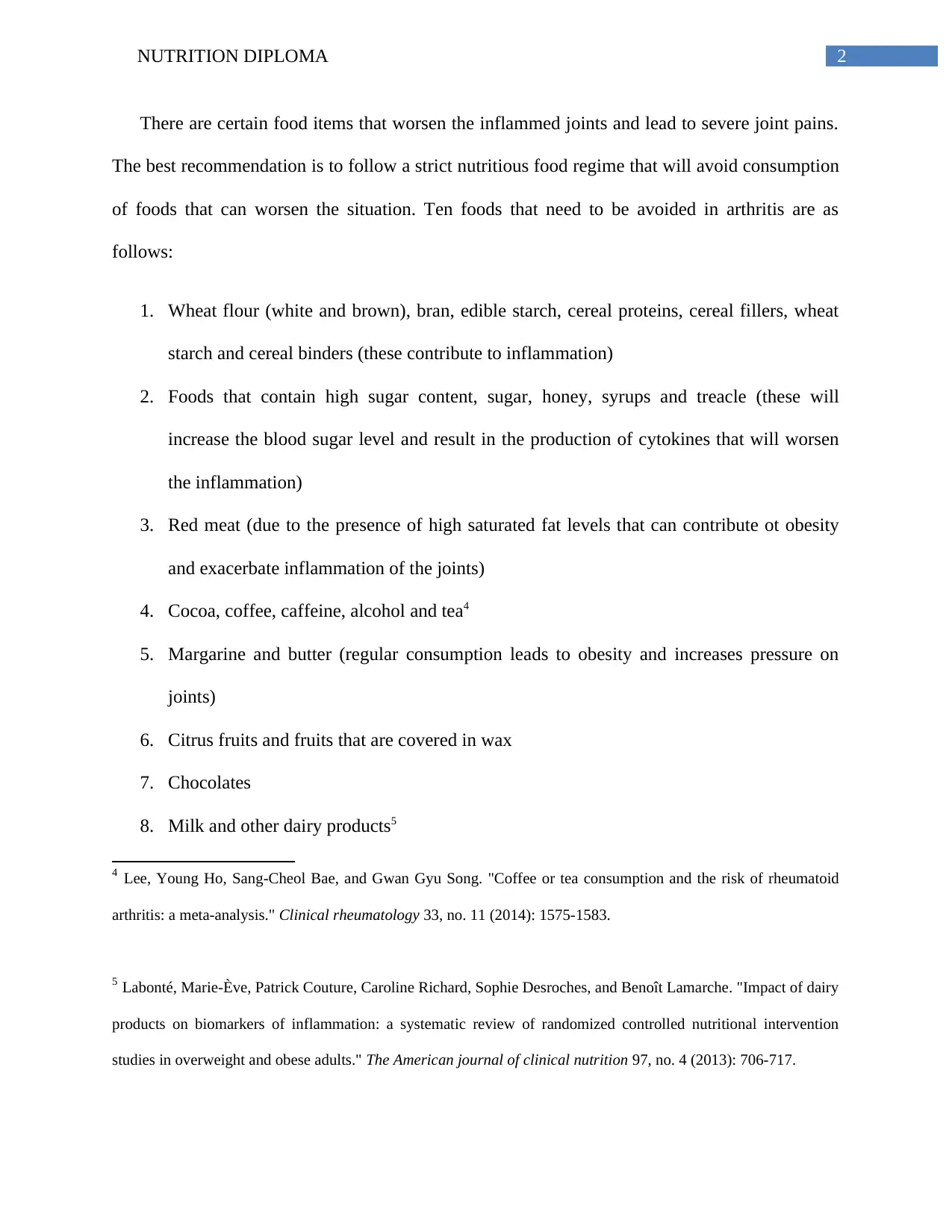
2NUTRITION DIPLOMA
There are certain food items that worsen the inflammed joints and lead to severe joint pains.
The best recommendation is to follow a strict nutritious food regime that will avoid consumption
of foods that can worsen the situation. Ten foods that need to be avoided in arthritis are as
follows:
1. Wheat flour (white and brown), bran, edible starch, cereal proteins, cereal fillers, wheat
starch and cereal binders (these contribute to inflammation)
2. Foods that contain high sugar content, sugar, honey, syrups and treacle (these will
increase the blood sugar level and result in the production of cytokines that will worsen
the inflammation)
3. Red meat (due to the presence of high saturated fat levels that can contribute ot obesity
and exacerbate inflammation of the joints)
4. Cocoa, coffee, caffeine, alcohol and tea4
5. Margarine and butter (regular consumption leads to obesity and increases pressure on
joints)
6. Citrus fruits and fruits that are covered in wax
7. Chocolates
8. Milk and other dairy products5
4 Lee, Young Ho, Sang-Cheol Bae, and Gwan Gyu Song. "Coffee or tea consumption and the risk of rheumatoid
arthritis: a meta-analysis." Clinical rheumatology 33, no. 11 (2014): 1575-1583.
5 Labonté, Marie-Ève, Patrick Couture, Caroline Richard, Sophie Desroches, and Benoît Lamarche. "Impact of dairy
products on biomarkers of inflammation: a systematic review of randomized controlled nutritional intervention
studies in overweight and obese adults." The American journal of clinical nutrition 97, no. 4 (2013): 706-717.
There are certain food items that worsen the inflammed joints and lead to severe joint pains.
The best recommendation is to follow a strict nutritious food regime that will avoid consumption
of foods that can worsen the situation. Ten foods that need to be avoided in arthritis are as
follows:
1. Wheat flour (white and brown), bran, edible starch, cereal proteins, cereal fillers, wheat
starch and cereal binders (these contribute to inflammation)
2. Foods that contain high sugar content, sugar, honey, syrups and treacle (these will
increase the blood sugar level and result in the production of cytokines that will worsen
the inflammation)
3. Red meat (due to the presence of high saturated fat levels that can contribute ot obesity
and exacerbate inflammation of the joints)
4. Cocoa, coffee, caffeine, alcohol and tea4
5. Margarine and butter (regular consumption leads to obesity and increases pressure on
joints)
6. Citrus fruits and fruits that are covered in wax
7. Chocolates
8. Milk and other dairy products5
4 Lee, Young Ho, Sang-Cheol Bae, and Gwan Gyu Song. "Coffee or tea consumption and the risk of rheumatoid
arthritis: a meta-analysis." Clinical rheumatology 33, no. 11 (2014): 1575-1583.
5 Labonté, Marie-Ève, Patrick Couture, Caroline Richard, Sophie Desroches, and Benoît Lamarche. "Impact of dairy
products on biomarkers of inflammation: a systematic review of randomized controlled nutritional intervention
studies in overweight and obese adults." The American journal of clinical nutrition 97, no. 4 (2013): 706-717.
⊘ This is a preview!⊘
Do you want full access?
Subscribe today to unlock all pages.

Trusted by 1+ million students worldwide
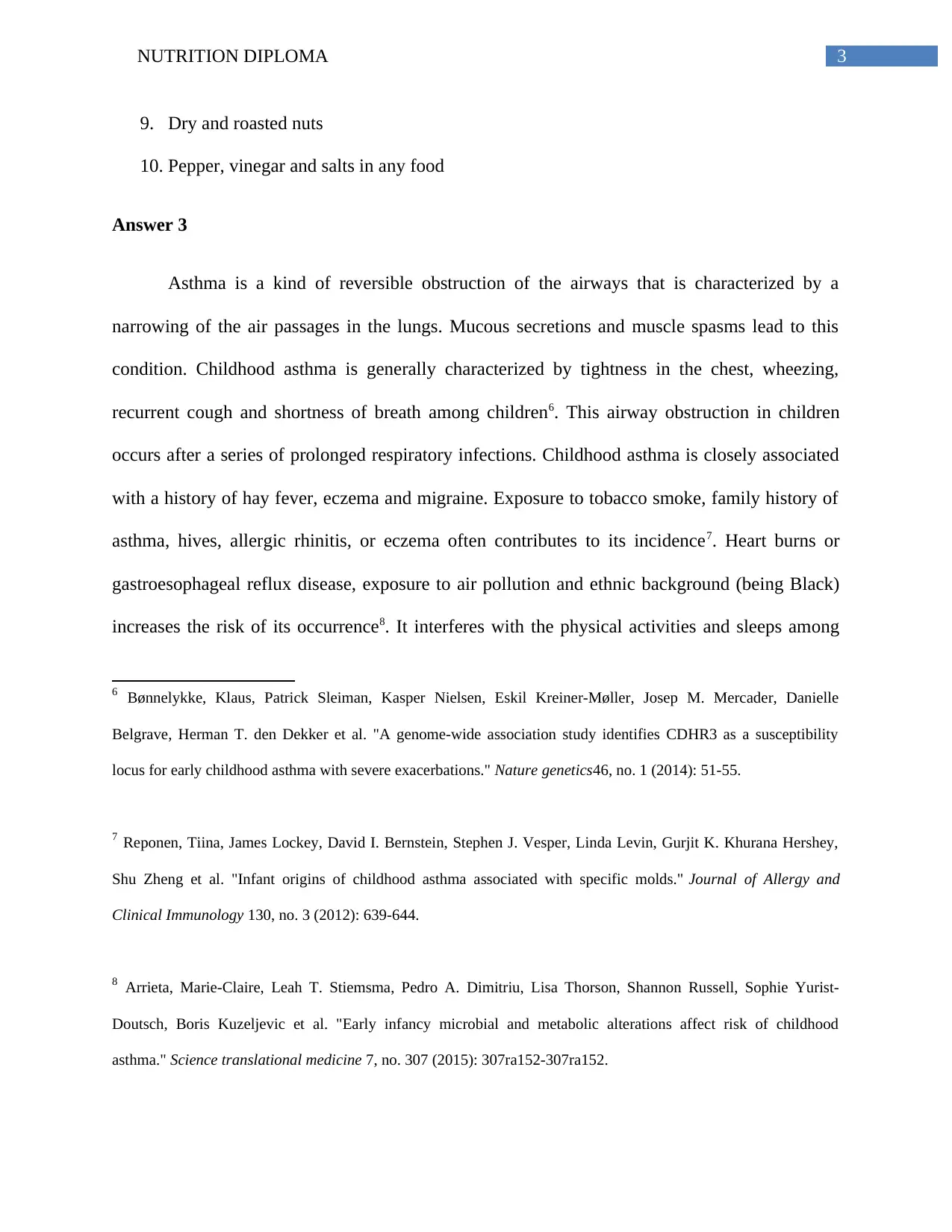
3NUTRITION DIPLOMA
9. Dry and roasted nuts
10. Pepper, vinegar and salts in any food
Answer 3
Asthma is a kind of reversible obstruction of the airways that is characterized by a
narrowing of the air passages in the lungs. Mucous secretions and muscle spasms lead to this
condition. Childhood asthma is generally characterized by tightness in the chest, wheezing,
recurrent cough and shortness of breath among children6. This airway obstruction in children
occurs after a series of prolonged respiratory infections. Childhood asthma is closely associated
with a history of hay fever, eczema and migraine. Exposure to tobacco smoke, family history of
asthma, hives, allergic rhinitis, or eczema often contributes to its incidence7. Heart burns or
gastroesophageal reflux disease, exposure to air pollution and ethnic background (being Black)
increases the risk of its occurrence8. It interferes with the physical activities and sleeps among
6 Bønnelykke, Klaus, Patrick Sleiman, Kasper Nielsen, Eskil Kreiner-Møller, Josep M. Mercader, Danielle
Belgrave, Herman T. den Dekker et al. "A genome-wide association study identifies CDHR3 as a susceptibility
locus for early childhood asthma with severe exacerbations." Nature genetics46, no. 1 (2014): 51-55.
7 Reponen, Tiina, James Lockey, David I. Bernstein, Stephen J. Vesper, Linda Levin, Gurjit K. Khurana Hershey,
Shu Zheng et al. "Infant origins of childhood asthma associated with specific molds." Journal of Allergy and
Clinical Immunology 130, no. 3 (2012): 639-644.
8 Arrieta, Marie-Claire, Leah T. Stiemsma, Pedro A. Dimitriu, Lisa Thorson, Shannon Russell, Sophie Yurist-
Doutsch, Boris Kuzeljevic et al. "Early infancy microbial and metabolic alterations affect risk of childhood
asthma." Science translational medicine 7, no. 307 (2015): 307ra152-307ra152.
9. Dry and roasted nuts
10. Pepper, vinegar and salts in any food
Answer 3
Asthma is a kind of reversible obstruction of the airways that is characterized by a
narrowing of the air passages in the lungs. Mucous secretions and muscle spasms lead to this
condition. Childhood asthma is generally characterized by tightness in the chest, wheezing,
recurrent cough and shortness of breath among children6. This airway obstruction in children
occurs after a series of prolonged respiratory infections. Childhood asthma is closely associated
with a history of hay fever, eczema and migraine. Exposure to tobacco smoke, family history of
asthma, hives, allergic rhinitis, or eczema often contributes to its incidence7. Heart burns or
gastroesophageal reflux disease, exposure to air pollution and ethnic background (being Black)
increases the risk of its occurrence8. It interferes with the physical activities and sleeps among
6 Bønnelykke, Klaus, Patrick Sleiman, Kasper Nielsen, Eskil Kreiner-Møller, Josep M. Mercader, Danielle
Belgrave, Herman T. den Dekker et al. "A genome-wide association study identifies CDHR3 as a susceptibility
locus for early childhood asthma with severe exacerbations." Nature genetics46, no. 1 (2014): 51-55.
7 Reponen, Tiina, James Lockey, David I. Bernstein, Stephen J. Vesper, Linda Levin, Gurjit K. Khurana Hershey,
Shu Zheng et al. "Infant origins of childhood asthma associated with specific molds." Journal of Allergy and
Clinical Immunology 130, no. 3 (2012): 639-644.
8 Arrieta, Marie-Claire, Leah T. Stiemsma, Pedro A. Dimitriu, Lisa Thorson, Shannon Russell, Sophie Yurist-
Doutsch, Boris Kuzeljevic et al. "Early infancy microbial and metabolic alterations affect risk of childhood
asthma." Science translational medicine 7, no. 307 (2015): 307ra152-307ra152.
Paraphrase This Document
Need a fresh take? Get an instant paraphrase of this document with our AI Paraphraser
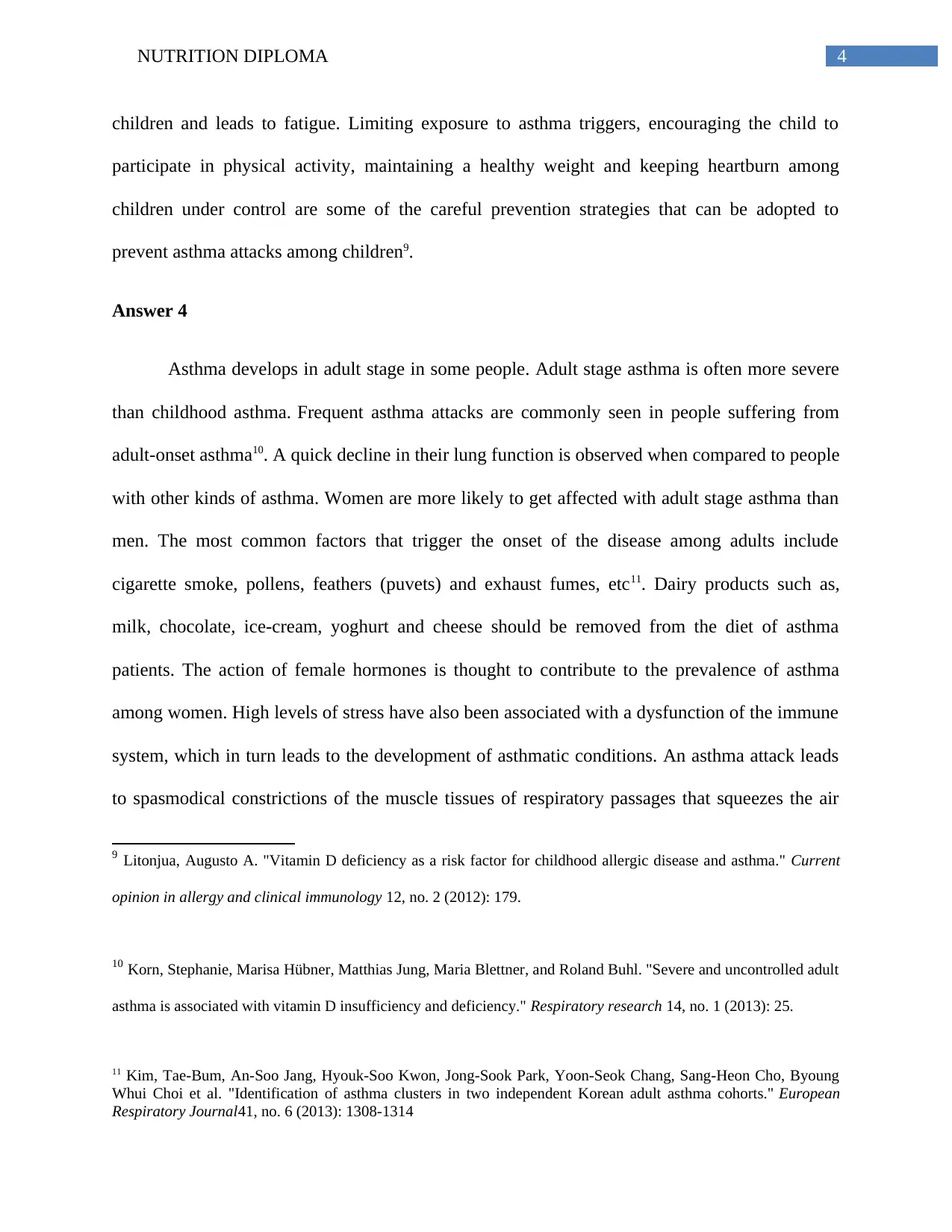
4NUTRITION DIPLOMA
children and leads to fatigue. Limiting exposure to asthma triggers, encouraging the child to
participate in physical activity, maintaining a healthy weight and keeping heartburn among
children under control are some of the careful prevention strategies that can be adopted to
prevent asthma attacks among children9.
Answer 4
Asthma develops in adult stage in some people. Adult stage asthma is often more severe
than childhood asthma. Frequent asthma attacks are commonly seen in people suffering from
adult-onset asthma10. A quick decline in their lung function is observed when compared to people
with other kinds of asthma. Women are more likely to get affected with adult stage asthma than
men. The most common factors that trigger the onset of the disease among adults include
cigarette smoke, pollens, feathers (puvets) and exhaust fumes, etc11. Dairy products such as,
milk, chocolate, ice-cream, yoghurt and cheese should be removed from the diet of asthma
patients. The action of female hormones is thought to contribute to the prevalence of asthma
among women. High levels of stress have also been associated with a dysfunction of the immune
system, which in turn leads to the development of asthmatic conditions. An asthma attack leads
to spasmodical constrictions of the muscle tissues of respiratory passages that squeezes the air
9 Litonjua, Augusto A. "Vitamin D deficiency as a risk factor for childhood allergic disease and asthma." Current
opinion in allergy and clinical immunology 12, no. 2 (2012): 179.
10 Korn, Stephanie, Marisa Hübner, Matthias Jung, Maria Blettner, and Roland Buhl. "Severe and uncontrolled adult
asthma is associated with vitamin D insufficiency and deficiency." Respiratory research 14, no. 1 (2013): 25.
11 Kim, Tae-Bum, An-Soo Jang, Hyouk-Soo Kwon, Jong-Sook Park, Yoon-Seok Chang, Sang-Heon Cho, Byoung
Whui Choi et al. "Identification of asthma clusters in two independent Korean adult asthma cohorts." European
Respiratory Journal41, no. 6 (2013): 1308-1314
children and leads to fatigue. Limiting exposure to asthma triggers, encouraging the child to
participate in physical activity, maintaining a healthy weight and keeping heartburn among
children under control are some of the careful prevention strategies that can be adopted to
prevent asthma attacks among children9.
Answer 4
Asthma develops in adult stage in some people. Adult stage asthma is often more severe
than childhood asthma. Frequent asthma attacks are commonly seen in people suffering from
adult-onset asthma10. A quick decline in their lung function is observed when compared to people
with other kinds of asthma. Women are more likely to get affected with adult stage asthma than
men. The most common factors that trigger the onset of the disease among adults include
cigarette smoke, pollens, feathers (puvets) and exhaust fumes, etc11. Dairy products such as,
milk, chocolate, ice-cream, yoghurt and cheese should be removed from the diet of asthma
patients. The action of female hormones is thought to contribute to the prevalence of asthma
among women. High levels of stress have also been associated with a dysfunction of the immune
system, which in turn leads to the development of asthmatic conditions. An asthma attack leads
to spasmodical constrictions of the muscle tissues of respiratory passages that squeezes the air
9 Litonjua, Augusto A. "Vitamin D deficiency as a risk factor for childhood allergic disease and asthma." Current
opinion in allergy and clinical immunology 12, no. 2 (2012): 179.
10 Korn, Stephanie, Marisa Hübner, Matthias Jung, Maria Blettner, and Roland Buhl. "Severe and uncontrolled adult
asthma is associated with vitamin D insufficiency and deficiency." Respiratory research 14, no. 1 (2013): 25.
11 Kim, Tae-Bum, An-Soo Jang, Hyouk-Soo Kwon, Jong-Sook Park, Yoon-Seok Chang, Sang-Heon Cho, Byoung
Whui Choi et al. "Identification of asthma clusters in two independent Korean adult asthma cohorts." European
Respiratory Journal41, no. 6 (2013): 1308-1314
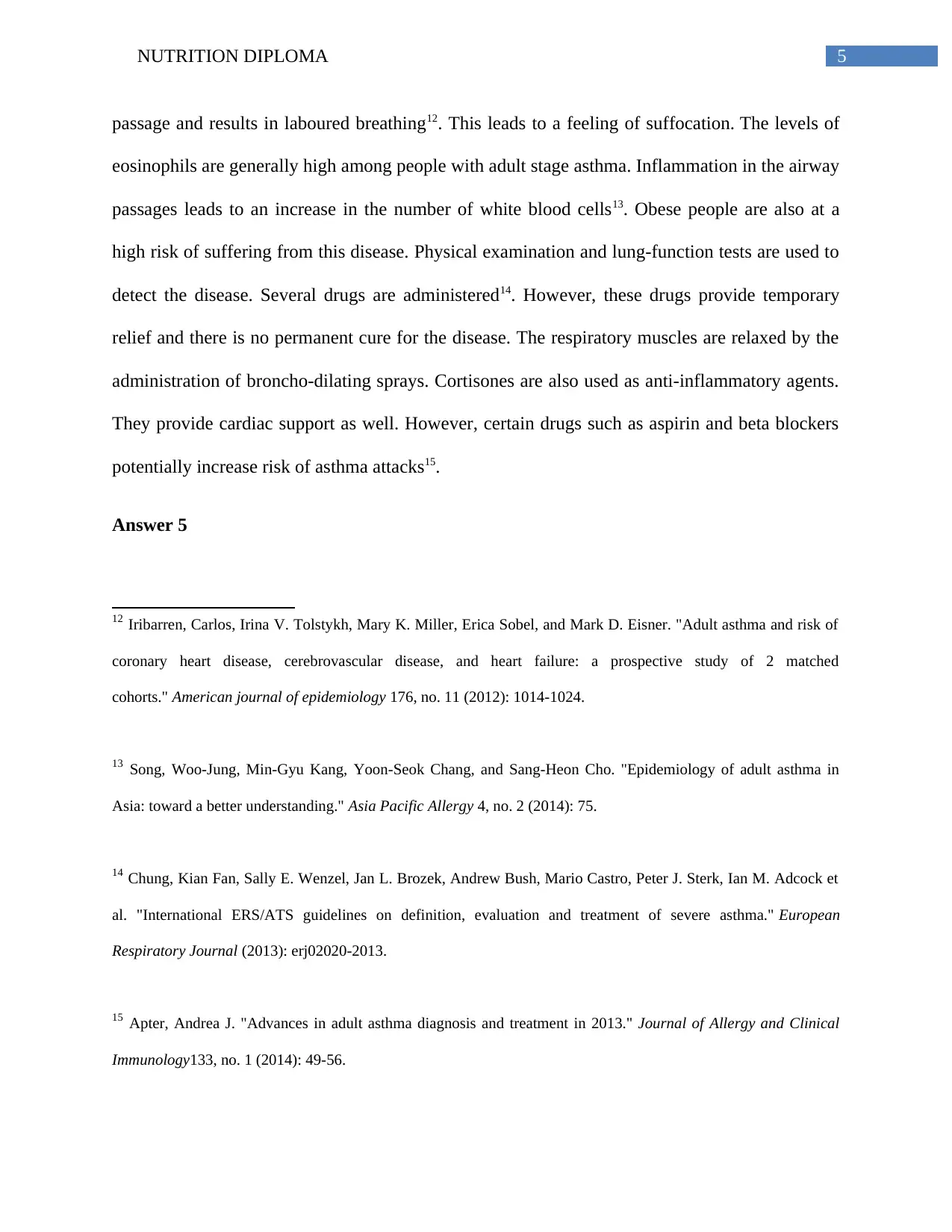
5NUTRITION DIPLOMA
passage and results in laboured breathing12. This leads to a feeling of suffocation. The levels of
eosinophils are generally high among people with adult stage asthma. Inflammation in the airway
passages leads to an increase in the number of white blood cells13. Obese people are also at a
high risk of suffering from this disease. Physical examination and lung-function tests are used to
detect the disease. Several drugs are administered14. However, these drugs provide temporary
relief and there is no permanent cure for the disease. The respiratory muscles are relaxed by the
administration of broncho-dilating sprays. Cortisones are also used as anti-inflammatory agents.
They provide cardiac support as well. However, certain drugs such as aspirin and beta blockers
potentially increase risk of asthma attacks15.
Answer 5
12 Iribarren, Carlos, Irina V. Tolstykh, Mary K. Miller, Erica Sobel, and Mark D. Eisner. "Adult asthma and risk of
coronary heart disease, cerebrovascular disease, and heart failure: a prospective study of 2 matched
cohorts." American journal of epidemiology 176, no. 11 (2012): 1014-1024.
13 Song, Woo-Jung, Min-Gyu Kang, Yoon-Seok Chang, and Sang-Heon Cho. "Epidemiology of adult asthma in
Asia: toward a better understanding." Asia Pacific Allergy 4, no. 2 (2014): 75.
14 Chung, Kian Fan, Sally E. Wenzel, Jan L. Brozek, Andrew Bush, Mario Castro, Peter J. Sterk, Ian M. Adcock et
al. "International ERS/ATS guidelines on definition, evaluation and treatment of severe asthma." European
Respiratory Journal (2013): erj02020-2013.
15 Apter, Andrea J. "Advances in adult asthma diagnosis and treatment in 2013." Journal of Allergy and Clinical
Immunology133, no. 1 (2014): 49-56.
passage and results in laboured breathing12. This leads to a feeling of suffocation. The levels of
eosinophils are generally high among people with adult stage asthma. Inflammation in the airway
passages leads to an increase in the number of white blood cells13. Obese people are also at a
high risk of suffering from this disease. Physical examination and lung-function tests are used to
detect the disease. Several drugs are administered14. However, these drugs provide temporary
relief and there is no permanent cure for the disease. The respiratory muscles are relaxed by the
administration of broncho-dilating sprays. Cortisones are also used as anti-inflammatory agents.
They provide cardiac support as well. However, certain drugs such as aspirin and beta blockers
potentially increase risk of asthma attacks15.
Answer 5
12 Iribarren, Carlos, Irina V. Tolstykh, Mary K. Miller, Erica Sobel, and Mark D. Eisner. "Adult asthma and risk of
coronary heart disease, cerebrovascular disease, and heart failure: a prospective study of 2 matched
cohorts." American journal of epidemiology 176, no. 11 (2012): 1014-1024.
13 Song, Woo-Jung, Min-Gyu Kang, Yoon-Seok Chang, and Sang-Heon Cho. "Epidemiology of adult asthma in
Asia: toward a better understanding." Asia Pacific Allergy 4, no. 2 (2014): 75.
14 Chung, Kian Fan, Sally E. Wenzel, Jan L. Brozek, Andrew Bush, Mario Castro, Peter J. Sterk, Ian M. Adcock et
al. "International ERS/ATS guidelines on definition, evaluation and treatment of severe asthma." European
Respiratory Journal (2013): erj02020-2013.
15 Apter, Andrea J. "Advances in adult asthma diagnosis and treatment in 2013." Journal of Allergy and Clinical
Immunology133, no. 1 (2014): 49-56.
⊘ This is a preview!⊘
Do you want full access?
Subscribe today to unlock all pages.

Trusted by 1+ million students worldwide
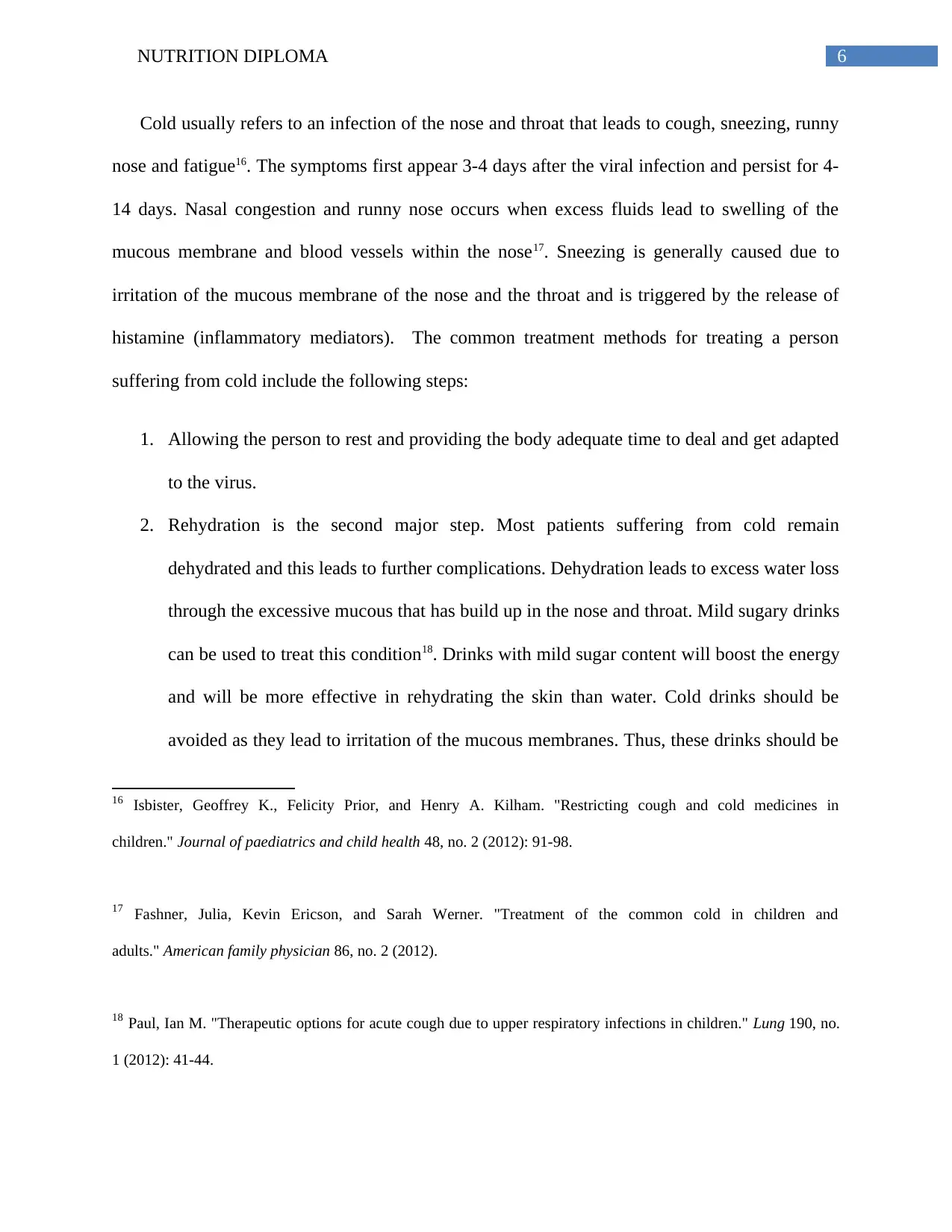
6NUTRITION DIPLOMA
Cold usually refers to an infection of the nose and throat that leads to cough, sneezing, runny
nose and fatigue16. The symptoms first appear 3-4 days after the viral infection and persist for 4-
14 days. Nasal congestion and runny nose occurs when excess fluids lead to swelling of the
mucous membrane and blood vessels within the nose17. Sneezing is generally caused due to
irritation of the mucous membrane of the nose and the throat and is triggered by the release of
histamine (inflammatory mediators). The common treatment methods for treating a person
suffering from cold include the following steps:
1. Allowing the person to rest and providing the body adequate time to deal and get adapted
to the virus.
2. Rehydration is the second major step. Most patients suffering from cold remain
dehydrated and this leads to further complications. Dehydration leads to excess water loss
through the excessive mucous that has build up in the nose and throat. Mild sugary drinks
can be used to treat this condition18. Drinks with mild sugar content will boost the energy
and will be more effective in rehydrating the skin than water. Cold drinks should be
avoided as they lead to irritation of the mucous membranes. Thus, these drinks should be
16 Isbister, Geoffrey K., Felicity Prior, and Henry A. Kilham. "Restricting cough and cold medicines in
children." Journal of paediatrics and child health 48, no. 2 (2012): 91-98.
17 Fashner, Julia, Kevin Ericson, and Sarah Werner. "Treatment of the common cold in children and
adults." American family physician 86, no. 2 (2012).
18 Paul, Ian M. "Therapeutic options for acute cough due to upper respiratory infections in children." Lung 190, no.
1 (2012): 41-44.
Cold usually refers to an infection of the nose and throat that leads to cough, sneezing, runny
nose and fatigue16. The symptoms first appear 3-4 days after the viral infection and persist for 4-
14 days. Nasal congestion and runny nose occurs when excess fluids lead to swelling of the
mucous membrane and blood vessels within the nose17. Sneezing is generally caused due to
irritation of the mucous membrane of the nose and the throat and is triggered by the release of
histamine (inflammatory mediators). The common treatment methods for treating a person
suffering from cold include the following steps:
1. Allowing the person to rest and providing the body adequate time to deal and get adapted
to the virus.
2. Rehydration is the second major step. Most patients suffering from cold remain
dehydrated and this leads to further complications. Dehydration leads to excess water loss
through the excessive mucous that has build up in the nose and throat. Mild sugary drinks
can be used to treat this condition18. Drinks with mild sugar content will boost the energy
and will be more effective in rehydrating the skin than water. Cold drinks should be
avoided as they lead to irritation of the mucous membranes. Thus, these drinks should be
16 Isbister, Geoffrey K., Felicity Prior, and Henry A. Kilham. "Restricting cough and cold medicines in
children." Journal of paediatrics and child health 48, no. 2 (2012): 91-98.
17 Fashner, Julia, Kevin Ericson, and Sarah Werner. "Treatment of the common cold in children and
adults." American family physician 86, no. 2 (2012).
18 Paul, Ian M. "Therapeutic options for acute cough due to upper respiratory infections in children." Lung 190, no.
1 (2012): 41-44.
Paraphrase This Document
Need a fresh take? Get an instant paraphrase of this document with our AI Paraphraser
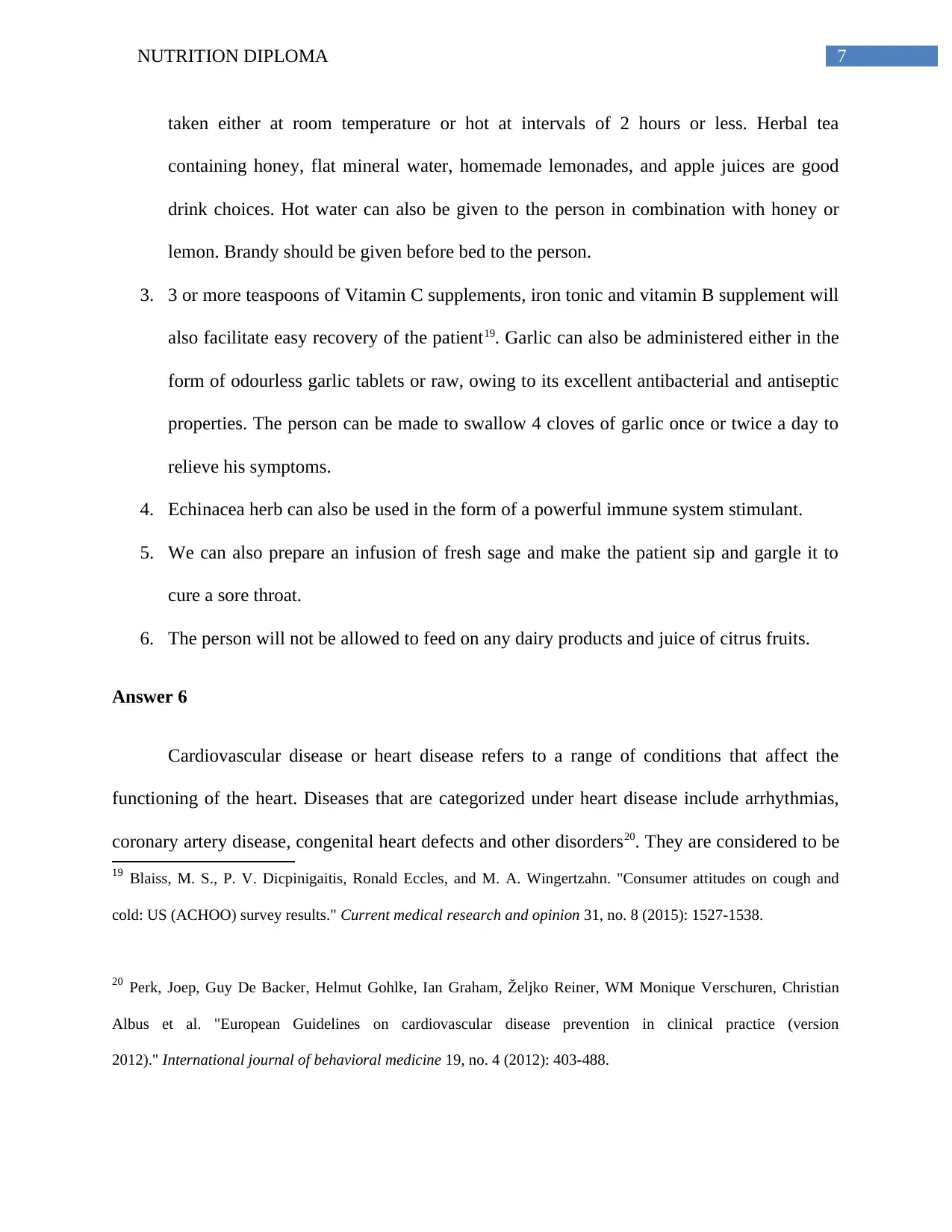
7NUTRITION DIPLOMA
taken either at room temperature or hot at intervals of 2 hours or less. Herbal tea
containing honey, flat mineral water, homemade lemonades, and apple juices are good
drink choices. Hot water can also be given to the person in combination with honey or
lemon. Brandy should be given before bed to the person.
3. 3 or more teaspoons of Vitamin C supplements, iron tonic and vitamin B supplement will
also facilitate easy recovery of the patient19. Garlic can also be administered either in the
form of odourless garlic tablets or raw, owing to its excellent antibacterial and antiseptic
properties. The person can be made to swallow 4 cloves of garlic once or twice a day to
relieve his symptoms.
4. Echinacea herb can also be used in the form of a powerful immune system stimulant.
5. We can also prepare an infusion of fresh sage and make the patient sip and gargle it to
cure a sore throat.
6. The person will not be allowed to feed on any dairy products and juice of citrus fruits.
Answer 6
Cardiovascular disease or heart disease refers to a range of conditions that affect the
functioning of the heart. Diseases that are categorized under heart disease include arrhythmias,
coronary artery disease, congenital heart defects and other disorders20. They are considered to be
19 Blaiss, M. S., P. V. Dicpinigaitis, Ronald Eccles, and M. A. Wingertzahn. "Consumer attitudes on cough and
cold: US (ACHOO) survey results." Current medical research and opinion 31, no. 8 (2015): 1527-1538.
20 Perk, Joep, Guy De Backer, Helmut Gohlke, Ian Graham, Željko Reiner, WM Monique Verschuren, Christian
Albus et al. "European Guidelines on cardiovascular disease prevention in clinical practice (version
2012)." International journal of behavioral medicine 19, no. 4 (2012): 403-488.
taken either at room temperature or hot at intervals of 2 hours or less. Herbal tea
containing honey, flat mineral water, homemade lemonades, and apple juices are good
drink choices. Hot water can also be given to the person in combination with honey or
lemon. Brandy should be given before bed to the person.
3. 3 or more teaspoons of Vitamin C supplements, iron tonic and vitamin B supplement will
also facilitate easy recovery of the patient19. Garlic can also be administered either in the
form of odourless garlic tablets or raw, owing to its excellent antibacterial and antiseptic
properties. The person can be made to swallow 4 cloves of garlic once or twice a day to
relieve his symptoms.
4. Echinacea herb can also be used in the form of a powerful immune system stimulant.
5. We can also prepare an infusion of fresh sage and make the patient sip and gargle it to
cure a sore throat.
6. The person will not be allowed to feed on any dairy products and juice of citrus fruits.
Answer 6
Cardiovascular disease or heart disease refers to a range of conditions that affect the
functioning of the heart. Diseases that are categorized under heart disease include arrhythmias,
coronary artery disease, congenital heart defects and other disorders20. They are considered to be
19 Blaiss, M. S., P. V. Dicpinigaitis, Ronald Eccles, and M. A. Wingertzahn. "Consumer attitudes on cough and
cold: US (ACHOO) survey results." Current medical research and opinion 31, no. 8 (2015): 1527-1538.
20 Perk, Joep, Guy De Backer, Helmut Gohlke, Ian Graham, Željko Reiner, WM Monique Verschuren, Christian
Albus et al. "European Guidelines on cardiovascular disease prevention in clinical practice (version
2012)." International journal of behavioral medicine 19, no. 4 (2012): 403-488.
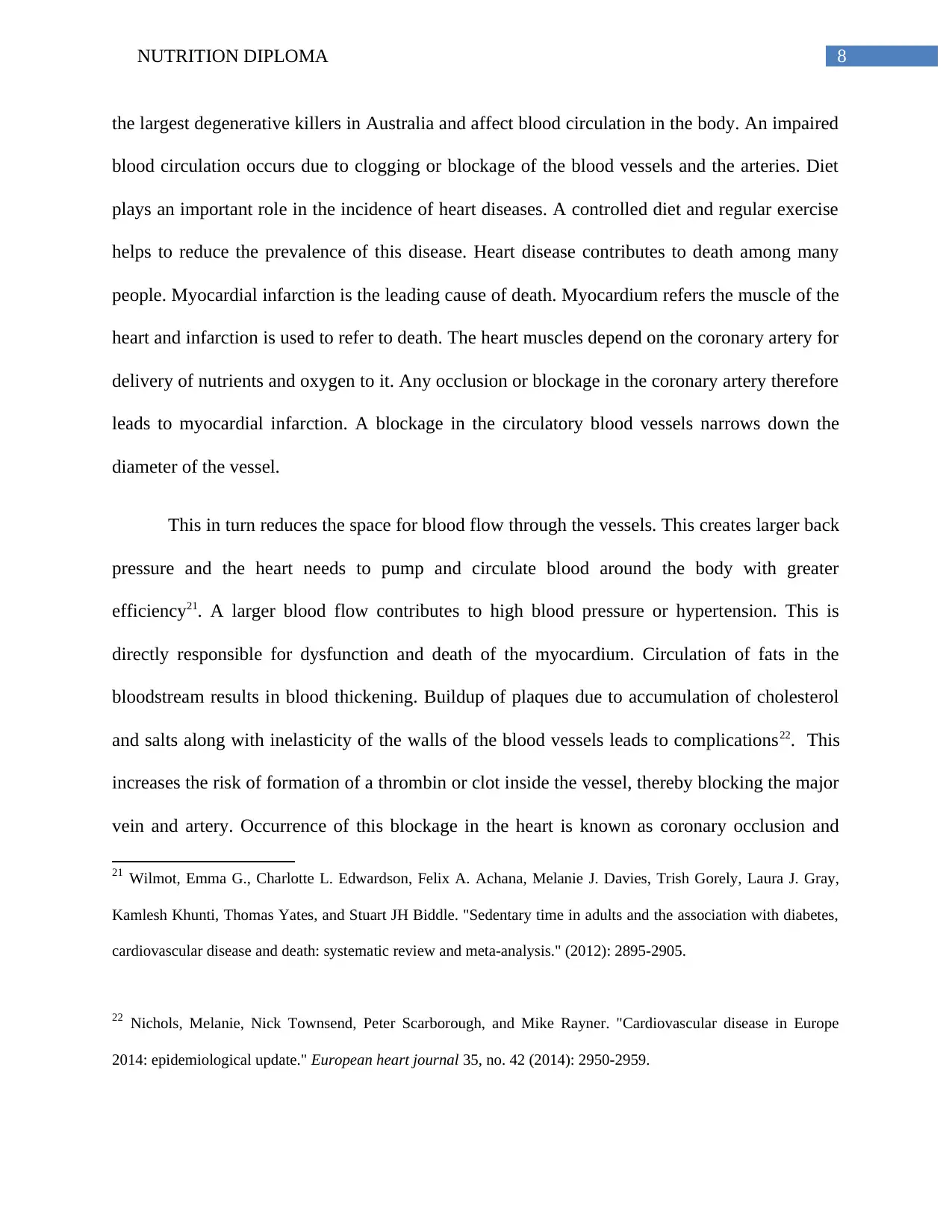
8NUTRITION DIPLOMA
the largest degenerative killers in Australia and affect blood circulation in the body. An impaired
blood circulation occurs due to clogging or blockage of the blood vessels and the arteries. Diet
plays an important role in the incidence of heart diseases. A controlled diet and regular exercise
helps to reduce the prevalence of this disease. Heart disease contributes to death among many
people. Myocardial infarction is the leading cause of death. Myocardium refers the muscle of the
heart and infarction is used to refer to death. The heart muscles depend on the coronary artery for
delivery of nutrients and oxygen to it. Any occlusion or blockage in the coronary artery therefore
leads to myocardial infarction. A blockage in the circulatory blood vessels narrows down the
diameter of the vessel.
This in turn reduces the space for blood flow through the vessels. This creates larger back
pressure and the heart needs to pump and circulate blood around the body with greater
efficiency21. A larger blood flow contributes to high blood pressure or hypertension. This is
directly responsible for dysfunction and death of the myocardium. Circulation of fats in the
bloodstream results in blood thickening. Buildup of plaques due to accumulation of cholesterol
and salts along with inelasticity of the walls of the blood vessels leads to complications22. This
increases the risk of formation of a thrombin or clot inside the vessel, thereby blocking the major
vein and artery. Occurrence of this blockage in the heart is known as coronary occlusion and
21 Wilmot, Emma G., Charlotte L. Edwardson, Felix A. Achana, Melanie J. Davies, Trish Gorely, Laura J. Gray,
Kamlesh Khunti, Thomas Yates, and Stuart JH Biddle. "Sedentary time in adults and the association with diabetes,
cardiovascular disease and death: systematic review and meta-analysis." (2012): 2895-2905.
22 Nichols, Melanie, Nick Townsend, Peter Scarborough, and Mike Rayner. "Cardiovascular disease in Europe
2014: epidemiological update." European heart journal 35, no. 42 (2014): 2950-2959.
the largest degenerative killers in Australia and affect blood circulation in the body. An impaired
blood circulation occurs due to clogging or blockage of the blood vessels and the arteries. Diet
plays an important role in the incidence of heart diseases. A controlled diet and regular exercise
helps to reduce the prevalence of this disease. Heart disease contributes to death among many
people. Myocardial infarction is the leading cause of death. Myocardium refers the muscle of the
heart and infarction is used to refer to death. The heart muscles depend on the coronary artery for
delivery of nutrients and oxygen to it. Any occlusion or blockage in the coronary artery therefore
leads to myocardial infarction. A blockage in the circulatory blood vessels narrows down the
diameter of the vessel.
This in turn reduces the space for blood flow through the vessels. This creates larger back
pressure and the heart needs to pump and circulate blood around the body with greater
efficiency21. A larger blood flow contributes to high blood pressure or hypertension. This is
directly responsible for dysfunction and death of the myocardium. Circulation of fats in the
bloodstream results in blood thickening. Buildup of plaques due to accumulation of cholesterol
and salts along with inelasticity of the walls of the blood vessels leads to complications22. This
increases the risk of formation of a thrombin or clot inside the vessel, thereby blocking the major
vein and artery. Occurrence of this blockage in the heart is known as coronary occlusion and
21 Wilmot, Emma G., Charlotte L. Edwardson, Felix A. Achana, Melanie J. Davies, Trish Gorely, Laura J. Gray,
Kamlesh Khunti, Thomas Yates, and Stuart JH Biddle. "Sedentary time in adults and the association with diabetes,
cardiovascular disease and death: systematic review and meta-analysis." (2012): 2895-2905.
22 Nichols, Melanie, Nick Townsend, Peter Scarborough, and Mike Rayner. "Cardiovascular disease in Europe
2014: epidemiological update." European heart journal 35, no. 42 (2014): 2950-2959.
⊘ This is a preview!⊘
Do you want full access?
Subscribe today to unlock all pages.

Trusted by 1+ million students worldwide
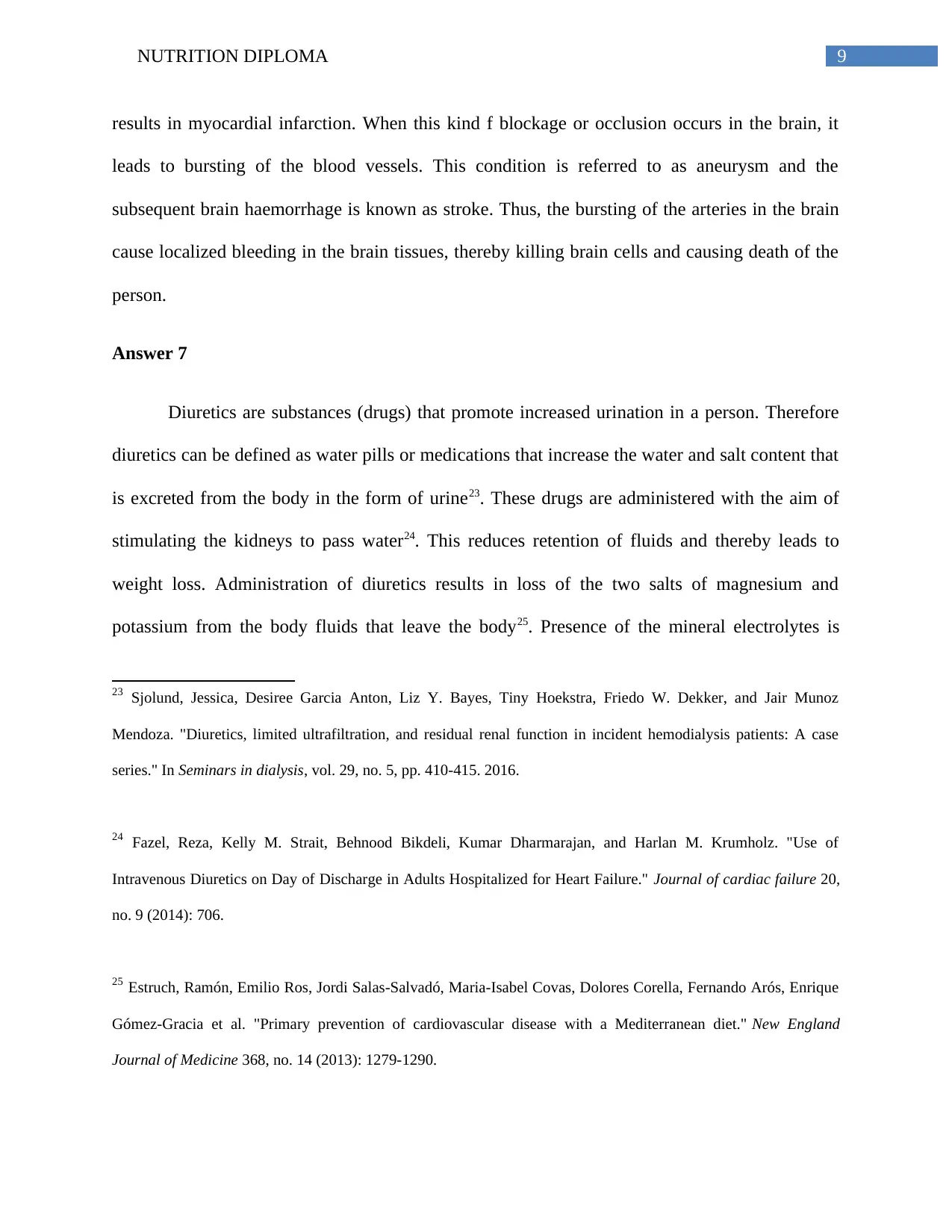
9NUTRITION DIPLOMA
results in myocardial infarction. When this kind f blockage or occlusion occurs in the brain, it
leads to bursting of the blood vessels. This condition is referred to as aneurysm and the
subsequent brain haemorrhage is known as stroke. Thus, the bursting of the arteries in the brain
cause localized bleeding in the brain tissues, thereby killing brain cells and causing death of the
person.
Answer 7
Diuretics are substances (drugs) that promote increased urination in a person. Therefore
diuretics can be defined as water pills or medications that increase the water and salt content that
is excreted from the body in the form of urine23. These drugs are administered with the aim of
stimulating the kidneys to pass water24. This reduces retention of fluids and thereby leads to
weight loss. Administration of diuretics results in loss of the two salts of magnesium and
potassium from the body fluids that leave the body25. Presence of the mineral electrolytes is
23 Sjolund, Jessica, Desiree Garcia Anton, Liz Y. Bayes, Tiny Hoekstra, Friedo W. Dekker, and Jair Munoz
Mendoza. "Diuretics, limited ultrafiltration, and residual renal function in incident hemodialysis patients: A case
series." In Seminars in dialysis, vol. 29, no. 5, pp. 410-415. 2016.
24 Fazel, Reza, Kelly M. Strait, Behnood Bikdeli, Kumar Dharmarajan, and Harlan M. Krumholz. "Use of
Intravenous Diuretics on Day of Discharge in Adults Hospitalized for Heart Failure." Journal of cardiac failure 20,
no. 9 (2014): 706.
25 Estruch, Ramón, Emilio Ros, Jordi Salas-Salvadó, Maria-Isabel Covas, Dolores Corella, Fernando Arós, Enrique
Gómez-Gracia et al. "Primary prevention of cardiovascular disease with a Mediterranean diet." New England
Journal of Medicine 368, no. 14 (2013): 1279-1290.
results in myocardial infarction. When this kind f blockage or occlusion occurs in the brain, it
leads to bursting of the blood vessels. This condition is referred to as aneurysm and the
subsequent brain haemorrhage is known as stroke. Thus, the bursting of the arteries in the brain
cause localized bleeding in the brain tissues, thereby killing brain cells and causing death of the
person.
Answer 7
Diuretics are substances (drugs) that promote increased urination in a person. Therefore
diuretics can be defined as water pills or medications that increase the water and salt content that
is excreted from the body in the form of urine23. These drugs are administered with the aim of
stimulating the kidneys to pass water24. This reduces retention of fluids and thereby leads to
weight loss. Administration of diuretics results in loss of the two salts of magnesium and
potassium from the body fluids that leave the body25. Presence of the mineral electrolytes is
23 Sjolund, Jessica, Desiree Garcia Anton, Liz Y. Bayes, Tiny Hoekstra, Friedo W. Dekker, and Jair Munoz
Mendoza. "Diuretics, limited ultrafiltration, and residual renal function in incident hemodialysis patients: A case
series." In Seminars in dialysis, vol. 29, no. 5, pp. 410-415. 2016.
24 Fazel, Reza, Kelly M. Strait, Behnood Bikdeli, Kumar Dharmarajan, and Harlan M. Krumholz. "Use of
Intravenous Diuretics on Day of Discharge in Adults Hospitalized for Heart Failure." Journal of cardiac failure 20,
no. 9 (2014): 706.
25 Estruch, Ramón, Emilio Ros, Jordi Salas-Salvadó, Maria-Isabel Covas, Dolores Corella, Fernando Arós, Enrique
Gómez-Gracia et al. "Primary prevention of cardiovascular disease with a Mediterranean diet." New England
Journal of Medicine 368, no. 14 (2013): 1279-1290.
Paraphrase This Document
Need a fresh take? Get an instant paraphrase of this document with our AI Paraphraser
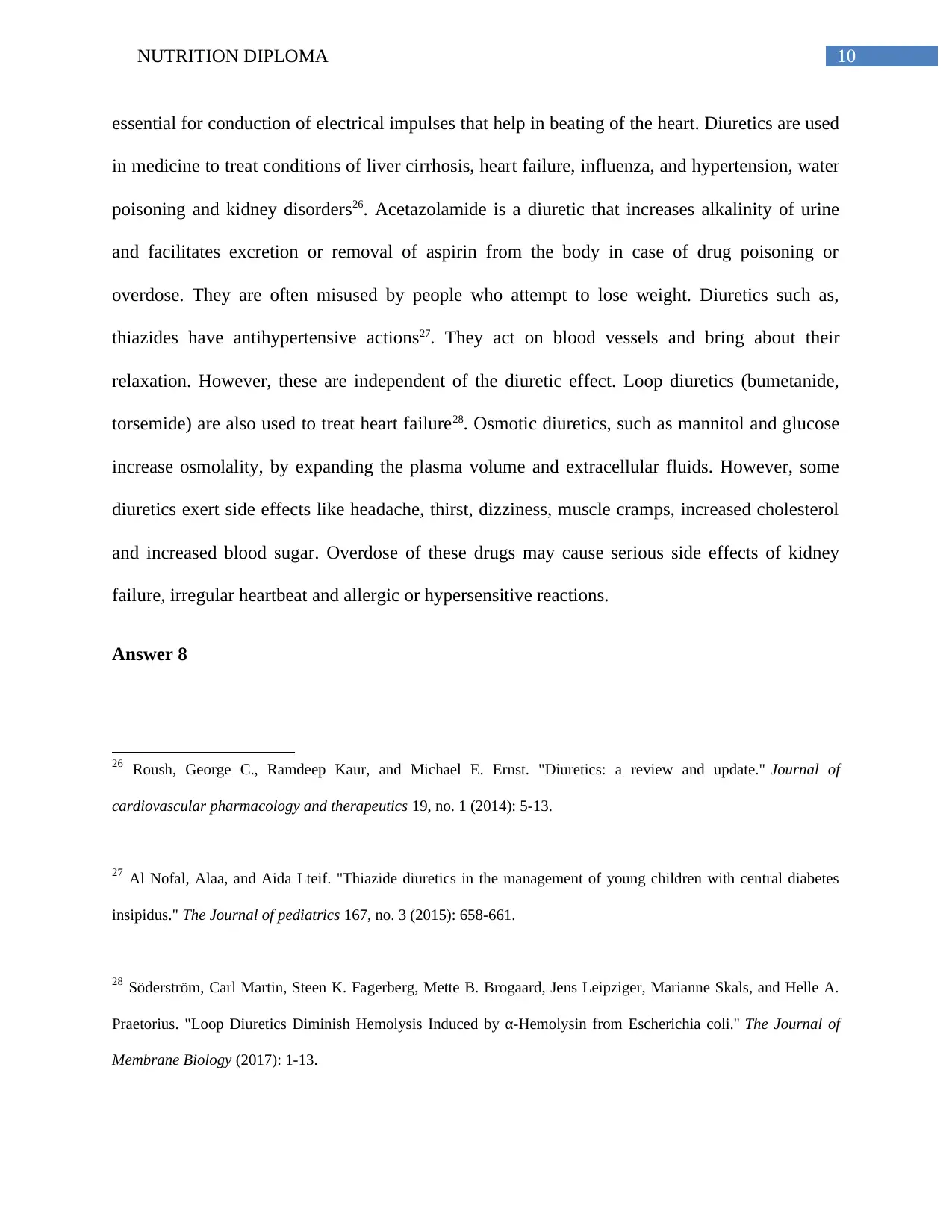
10NUTRITION DIPLOMA
essential for conduction of electrical impulses that help in beating of the heart. Diuretics are used
in medicine to treat conditions of liver cirrhosis, heart failure, influenza, and hypertension, water
poisoning and kidney disorders26. Acetazolamide is a diuretic that increases alkalinity of urine
and facilitates excretion or removal of aspirin from the body in case of drug poisoning or
overdose. They are often misused by people who attempt to lose weight. Diuretics such as,
thiazides have antihypertensive actions27. They act on blood vessels and bring about their
relaxation. However, these are independent of the diuretic effect. Loop diuretics (bumetanide,
torsemide) are also used to treat heart failure28. Osmotic diuretics, such as mannitol and glucose
increase osmolality, by expanding the plasma volume and extracellular fluids. However, some
diuretics exert side effects like headache, thirst, dizziness, muscle cramps, increased cholesterol
and increased blood sugar. Overdose of these drugs may cause serious side effects of kidney
failure, irregular heartbeat and allergic or hypersensitive reactions.
Answer 8
26 Roush, George C., Ramdeep Kaur, and Michael E. Ernst. "Diuretics: a review and update." Journal of
cardiovascular pharmacology and therapeutics 19, no. 1 (2014): 5-13.
27 Al Nofal, Alaa, and Aida Lteif. "Thiazide diuretics in the management of young children with central diabetes
insipidus." The Journal of pediatrics 167, no. 3 (2015): 658-661.
28 Söderström, Carl Martin, Steen K. Fagerberg, Mette B. Brogaard, Jens Leipziger, Marianne Skals, and Helle A.
Praetorius. "Loop Diuretics Diminish Hemolysis Induced by α-Hemolysin from Escherichia coli." The Journal of
Membrane Biology (2017): 1-13.
essential for conduction of electrical impulses that help in beating of the heart. Diuretics are used
in medicine to treat conditions of liver cirrhosis, heart failure, influenza, and hypertension, water
poisoning and kidney disorders26. Acetazolamide is a diuretic that increases alkalinity of urine
and facilitates excretion or removal of aspirin from the body in case of drug poisoning or
overdose. They are often misused by people who attempt to lose weight. Diuretics such as,
thiazides have antihypertensive actions27. They act on blood vessels and bring about their
relaxation. However, these are independent of the diuretic effect. Loop diuretics (bumetanide,
torsemide) are also used to treat heart failure28. Osmotic diuretics, such as mannitol and glucose
increase osmolality, by expanding the plasma volume and extracellular fluids. However, some
diuretics exert side effects like headache, thirst, dizziness, muscle cramps, increased cholesterol
and increased blood sugar. Overdose of these drugs may cause serious side effects of kidney
failure, irregular heartbeat and allergic or hypersensitive reactions.
Answer 8
26 Roush, George C., Ramdeep Kaur, and Michael E. Ernst. "Diuretics: a review and update." Journal of
cardiovascular pharmacology and therapeutics 19, no. 1 (2014): 5-13.
27 Al Nofal, Alaa, and Aida Lteif. "Thiazide diuretics in the management of young children with central diabetes
insipidus." The Journal of pediatrics 167, no. 3 (2015): 658-661.
28 Söderström, Carl Martin, Steen K. Fagerberg, Mette B. Brogaard, Jens Leipziger, Marianne Skals, and Helle A.
Praetorius. "Loop Diuretics Diminish Hemolysis Induced by α-Hemolysin from Escherichia coli." The Journal of
Membrane Biology (2017): 1-13.
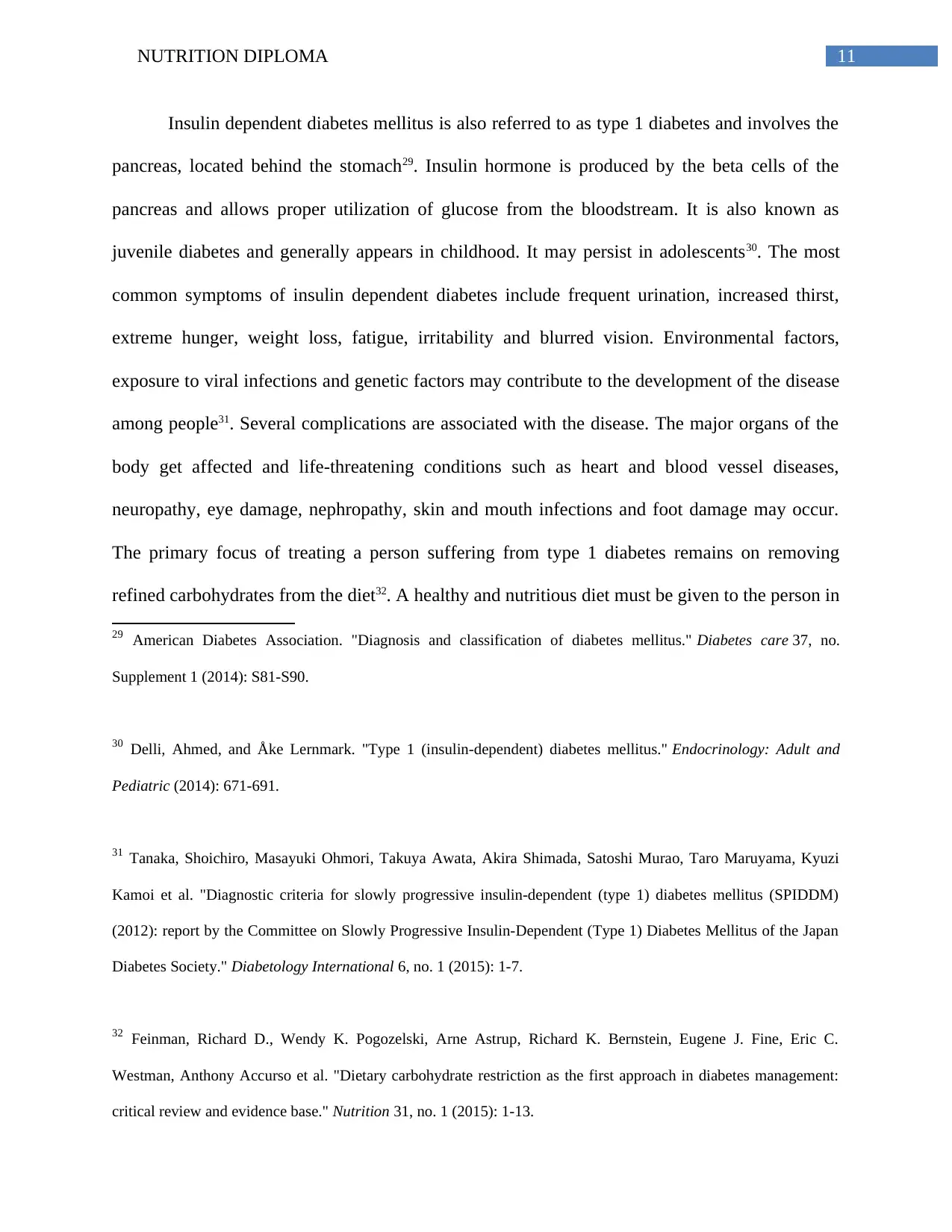
11NUTRITION DIPLOMA
Insulin dependent diabetes mellitus is also referred to as type 1 diabetes and involves the
pancreas, located behind the stomach29. Insulin hormone is produced by the beta cells of the
pancreas and allows proper utilization of glucose from the bloodstream. It is also known as
juvenile diabetes and generally appears in childhood. It may persist in adolescents30. The most
common symptoms of insulin dependent diabetes include frequent urination, increased thirst,
extreme hunger, weight loss, fatigue, irritability and blurred vision. Environmental factors,
exposure to viral infections and genetic factors may contribute to the development of the disease
among people31. Several complications are associated with the disease. The major organs of the
body get affected and life-threatening conditions such as heart and blood vessel diseases,
neuropathy, eye damage, nephropathy, skin and mouth infections and foot damage may occur.
The primary focus of treating a person suffering from type 1 diabetes remains on removing
refined carbohydrates from the diet32. A healthy and nutritious diet must be given to the person in
29 American Diabetes Association. "Diagnosis and classification of diabetes mellitus." Diabetes care 37, no.
Supplement 1 (2014): S81-S90.
30 Delli, Ahmed, and Åke Lernmark. "Type 1 (insulin-dependent) diabetes mellitus." Endocrinology: Adult and
Pediatric (2014): 671-691.
31 Tanaka, Shoichiro, Masayuki Ohmori, Takuya Awata, Akira Shimada, Satoshi Murao, Taro Maruyama, Kyuzi
Kamoi et al. "Diagnostic criteria for slowly progressive insulin-dependent (type 1) diabetes mellitus (SPIDDM)
(2012): report by the Committee on Slowly Progressive Insulin-Dependent (Type 1) Diabetes Mellitus of the Japan
Diabetes Society." Diabetology International 6, no. 1 (2015): 1-7.
32 Feinman, Richard D., Wendy K. Pogozelski, Arne Astrup, Richard K. Bernstein, Eugene J. Fine, Eric C.
Westman, Anthony Accurso et al. "Dietary carbohydrate restriction as the first approach in diabetes management:
critical review and evidence base." Nutrition 31, no. 1 (2015): 1-13.
Insulin dependent diabetes mellitus is also referred to as type 1 diabetes and involves the
pancreas, located behind the stomach29. Insulin hormone is produced by the beta cells of the
pancreas and allows proper utilization of glucose from the bloodstream. It is also known as
juvenile diabetes and generally appears in childhood. It may persist in adolescents30. The most
common symptoms of insulin dependent diabetes include frequent urination, increased thirst,
extreme hunger, weight loss, fatigue, irritability and blurred vision. Environmental factors,
exposure to viral infections and genetic factors may contribute to the development of the disease
among people31. Several complications are associated with the disease. The major organs of the
body get affected and life-threatening conditions such as heart and blood vessel diseases,
neuropathy, eye damage, nephropathy, skin and mouth infections and foot damage may occur.
The primary focus of treating a person suffering from type 1 diabetes remains on removing
refined carbohydrates from the diet32. A healthy and nutritious diet must be given to the person in
29 American Diabetes Association. "Diagnosis and classification of diabetes mellitus." Diabetes care 37, no.
Supplement 1 (2014): S81-S90.
30 Delli, Ahmed, and Åke Lernmark. "Type 1 (insulin-dependent) diabetes mellitus." Endocrinology: Adult and
Pediatric (2014): 671-691.
31 Tanaka, Shoichiro, Masayuki Ohmori, Takuya Awata, Akira Shimada, Satoshi Murao, Taro Maruyama, Kyuzi
Kamoi et al. "Diagnostic criteria for slowly progressive insulin-dependent (type 1) diabetes mellitus (SPIDDM)
(2012): report by the Committee on Slowly Progressive Insulin-Dependent (Type 1) Diabetes Mellitus of the Japan
Diabetes Society." Diabetology International 6, no. 1 (2015): 1-7.
32 Feinman, Richard D., Wendy K. Pogozelski, Arne Astrup, Richard K. Bernstein, Eugene J. Fine, Eric C.
Westman, Anthony Accurso et al. "Dietary carbohydrate restriction as the first approach in diabetes management:
critical review and evidence base." Nutrition 31, no. 1 (2015): 1-13.
⊘ This is a preview!⊘
Do you want full access?
Subscribe today to unlock all pages.

Trusted by 1+ million students worldwide
1 out of 26
Your All-in-One AI-Powered Toolkit for Academic Success.
+13062052269
info@desklib.com
Available 24*7 on WhatsApp / Email
![[object Object]](/_next/static/media/star-bottom.7253800d.svg)
Unlock your academic potential
Copyright © 2020–2025 A2Z Services. All Rights Reserved. Developed and managed by ZUCOL.